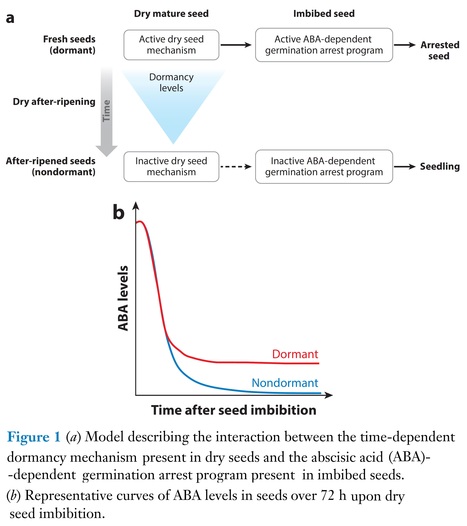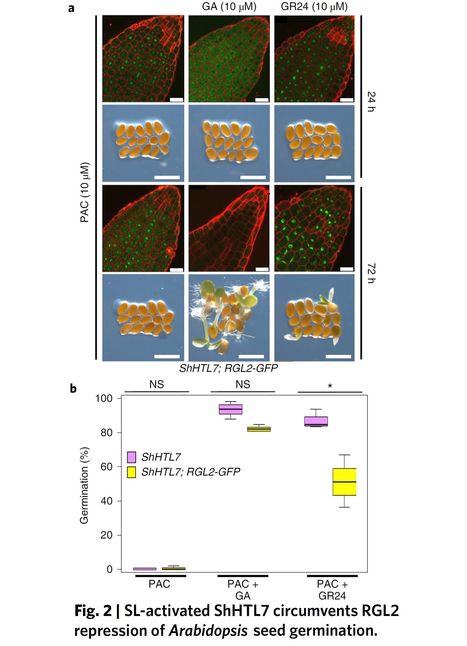 Your new post is loading...
 Your new post is loading...
Authors: Mayumi Iwasaki, Steven Penfield and Luis Lopez-Molina.
Annual Review of Plant Biology (2022)
Abstract: "Seed dormancy—the absence of seed germination under favorable germination conditions—is a plant trait that evolved to enhance seedling survival by avoiding germination under unsuitable environmental conditions. In Arabidopsis, dormancy levels are influenced by the seed coat composition, while the endosperm is essential to repress seed germination of dormant seeds upon their imbibition. Recent research has shown that the mother plant modulates its progeny seed dormancy in response to seasonal temperature changes by changing specific aspects of seed coat and endosperm development. This process involves genomic imprinting by means of epigenetic marks deposited in the seed progeny and regulators previously known to regulate flowering time. This review discusses and summarizes these discoveries and provides an update on our present understanding of the role of DOG1 and abscisic acid, two key contributors to dormancy."
Via Julio Retamales
Authors: Hu-Hui Chen, Jianhua Tong, Wei Fu, Zhenwei Liang, Jiuxiao Ruan, Yaoguang Yu, Xin Song, Liangbing Yuan, Langtao Xiao, Jun Liu, Yuhai Cui, Shangzhi Huang and Chenlong Li.
Plant Physiology (2020)
Abstract: "Seed dormancy is an adaptive trait that is crucial to plant survival. Abscisic acid (ABA) is the primary phytohormone that induces seed dormancy. However, little is known about how the level of ABA in seeds is determined. Here we show that the Arabidopsis thaliana H3K27me3 demethylase RELATIVE OF EARLY FLOWERING 6 (REF6) suppresses seed dormancy by inducing ABA catabolism in seeds. Seeds of the ref6 loss-of-function mutants displayed enhanced dormancy that was associated with increased endogenous ABA content. We further show that the transcripts of two genes key to ABA catabolism, CYP707A1 and CYP707A3, but not genes involved in ABA biosynthesis, were significantly reduced in ref6 mutants during seed development and germination. In developing siliques, REF6 bound directly to CYP707A1 and CYP707A3, and was responsible for reducing their H3K27me3 levels. Genetic analysis demonstrated that the enhanced seed dormancy and ABA concentration in ref6 depended mainly on the reduced expression of CYP707A1 and CYP707A3. Conversely, overexpression of CYP707A1 could offset the enhanced seed dormancy of ref6. Taken together, our results revealed an epigenetic regulation mechanism that is involved in the regulation of ABA content in seeds."
Authors: Jack Mitchell, Nur K. Mukhtar and George W. Bassel.
Seed Science Research (2020)
Abstract: "The timing of the germination of seeds is highly responsive to inputs from the environment. Temperature plays a key role in the control of germination, with low temperatures acting to stimulate this developmental transition in many species. In Arabidopsis, extensive gene expression changes have been reported at the whole seed level in response to cold, while much less is known about their spatial distribution across the diverse cell types of the embryo. In this study we examined the spatiotemporal patterns of promoter activity and protein abundance for key gibberellic acid (GA) and abscisic acid (ABA) factors which regulate the decision to germinate both during a time course of germination and in response to cold. Low temperature stimulated the spatial relocalization of these factors to the vasculature. The response of these seeds to dormancy-breaking stratification treatments therefore stimulates the distribution of both positive (GA) and negatively acting (ABA) components to this same cell type. This altered spatial pattern persisted following the transfer of seeds to 22°C, as well as after their rehydration, indicating that this alteration is persistent. These observations suggest that the vasculature plays a role in the low temperature-mediated stimulation of germination in this species, while novel cell types are recruited to promote germination in response to stratification."
Authors: Amber L. Hauvermale and Camille M. Steber.
Plant Signaling & Behavior (2020)
Abstract: "The plant hormone gibberellin (GA) stimulates developmental transitions including seed germination, flowering, and the transition from juvenile to adult growth stage. This study provided evidence that GA and the GA receptor GID1 (GA-INSENSITIVE DWARF1) are also needed for the embryo-to-seedling transition in Arabidopsis. The ga1-3 GA biosynthesis mutant fails to germinate unless GA is applied, whereas the gid1abc triple mutant fails to germinate because it cannot perceive endogenous or applied GA. Overexpression of the GID1a, GID1b, and GID1c GA receptors rescued the germination of a small percentage of ga1-3 seeds without GA application, and this rescue was improved by dormancy-breaking treatments, after-ripening and cold stratification. While GID1 overexpression stimulated ga1-3 seed germination, this germination was aberrant suggesting incomplete rescue of the germination process. Cotyledons emerged before the radicle, and the resulting “ghost” seedlings failed to develop a primary root, lost green coloration, and eventually died. The development of ga1-3 seedlings overexpressing GID1 was rescued by pre-germinative but not post-germinative GA application. Since the gid1abc mutant also exhibited a ghost phenotype after germination was rescued by cutting the seed coat, we concluded that both GA and GID1 are needed for the embryo-to-seedling transition prior to emergence from the seed coat."
Authors: Mengjuan Bai, Jingjing Sun, Jinyi Liu, Haoran Ren, Kang Wang, Yanling Wang, Changquan Wang and Katayoon Dehesh.
The Plant Journal (2019)
Abstract: "Seed germination is a fundamental process in plant life cycle regulated by functionally opposing internal and external inputs. Here, we explored the role of a negative regulator of photomorphogenesis, a B‐box containing protein (BBX19), as a molecular link between the inhibitory action of the phytohormone abscisic acid (ABA) and promoting role of light in germination. We show that seeds of BBX19 overexpressing lines, in contrast to those of BBX19 RNAi, display ABA hypersensitivity, albeit independently of elongated hypocotyl 5 (HY5). Moreover, we establish that BBX19 function is neither via perturbation of the GA signaling, the ABA antagonistic phytohormone, nor through interference with the germination repressors, DELLA proteins. Rather, BBX19 functions as an inducer of ABA INSENSITIVE5 (ABI5) by binding to the light‐responsive GT1‐motifs in the gene promoter. In summary, we identify BBX19 as a regulatory checkpoint directing diverse developmental processes, and tailoring adaptive responses to distinct endogenous and exogenous signals."
|
Authors: Chiara Longo, Soyanni Holness, Veronica De Angelis, Andrea Lepri, Sara Occhigrossi, Veronica Ruta and Paola Vittorioso.
Genes (2021)
Abstract: "The transition from a dormant to a germinating seed represents a crucial developmental switch in the life cycle of a plant. Subsequent transition from a germinating seed to an autotrophic organism also requires a robust and multi-layered control. Seed germination and seedling growth are multistep processes, involving both internal and external signals, which lead to a fine-tuning control network. In recent years, numerous studies have contributed to elucidate the molecular mechanisms underlying these processes: from light signaling and light-hormone crosstalk to the effects of abiotic stresses, from epigenetic regulation to translational control. However, there are still many open questions and molecular elements to be identified. This review will focus on the different aspects of the molecular control of seed dormancy and germination, pointing out new molecular elements and how these integrate in the signaling pathways already known.
Via Julio Retamales
Authors: Michael Bunsick, Shigeo Toh, Cynthia Wong, Zhenhua Xu, George Ly, Christopher S. P. McErlean, Gianni Pescetto, Kawther Elfituri Nemrish, Priscilla Sung, Jack Daiyang Li, Julie D. Scholes and Shelley Lumba.
Nature Plants (2020)
Editor's view: The parasitic plant Striga hermonthica germinates when it senses strigolactones (SLs). By expressing Striga SL receptors in Arabidopsis, the authors show that the SL pathway can regulate germination independently of gibberellin signalling.
Abstract: "Parasitic plant infestations dramatically reduce the yield of many major food crops of sub-Saharan Africa and pose a serious threat to food security on that continent1. The first committed step of a successful infestation is the germination of parasite seeds primarily in response to a group of related small-molecule hormones called strigolactones (SLs), which are emitted by host roots2. Despite the important role of SLs, it is not clear how host-derived SLs germinate parasitic plants. In contrast, gibberellins (GA) acts as the dominant hormone for stimulation of germination in non-parasitic plant species by inhibiting a set of DELLA repressors3. Here, we show that expression of SL receptors from the parasitic plant Striga hermonthica in the presence of SLs circumvents the GA requirement for germination of Arabidopsis thaliana seed. Striga receptors co-opt and enhance signalling through the HYPOSENSITIVE TO LIGHT/KARRIKIN INSENSITIVE 2 (AtHTL/KAI2) pathway, which normally plays a rudimentary role in Arabidopsis seed germination4,5. AtHTL/KAI2 negatively controls the SUPPRESSOR OF MAX2 1 (SMAX1) protein5, and loss of SMAX1 function allows germination in the presence of DELLA repressors. Our data suggest that ligand-dependent inactivation of SMAX1 in Striga and Arabidopsis can bypass GA-dependent germination in these species."
Authors: Shah Hussain, Sun Ho Kim, Sunghwa Bahk, Akhtar Ali, Xuan Canh Nguyen, Dae-Jin Yun and Woo Sik Chung.
Frontiers in Plant Science (2020)
Abstract: "Seed germination is a complex biological process controlled by various regulators, including phytohormones. Among these, abscisic acid and gibberellic acid inhibit and promote seed germination, respectively. Many studies have addressed the biological roles of auxin in plant growth and development, but very few have considered its role in seed germination. Here, we identified a novel function of the auxin signaling repressor Aux/IAA8 during seed germination. The IAA8 loss-of-function mutant iaa8-1 exhibited delayed seed germination. The phenotype of iaa8-1 was restored by ectopic expression of IAA8. Interestingly, IAA8 accumulated to high levels during seed germination, which was achieved not only by increased protein synthesis but also by the stabilization of IAA8 protein. We also showed that IAA8 down-regulates the transcription of ABSCISIC ACID INSENSITIVE3 (ABI3), a negative regulator of seed germination. Our study, thus strongly suggest that the auxin signaling repressor IAA8 acts as a positive regulator of seed germination in Arabidopsis thaliana."
Authors: Dawei Dai, Hongyang Tong, Lijun Cheng, Fei Peng, Tingting Zhang, Weiwei Qi and Rentao Song.
Journal of Experimental Botany (2019)
Abstract: "The maize (Zea mays) classic kernel mutant defective kernel 33 (dek33) produced defective and occasionally viviparous kernel phenotype. In this study, we cloned Dek33 by positional cloning and found that it encodes the pyrimidine reductase in riboflavin biosynthesis. In dek33, a single base mutation (G-to-A) in the C-terminal COG3236 domain caused a premature stop codon (TGA), producing a weak mutant allele with significant reduction of truncated DEK33 protein and riboflavin content. The dek33 mutation significantly affected oilbody formation and suppressed endoreduplication. The dek33 mutation also disrupted ABA biosynthesis, resulting in less ABA content, which might be responsible for the viviparous embryo. In addition, our results indicated that the COG3236 domain is important for the protein stability of DEK33. The yeast two-hybrid experiment identified several proteins that interact with DEK33, including RGLG2 and SnRK1, suggesting possible post-translational regulation to DEK33 stability. The interaction between DEK33 and these proteins was further confirmed by luciferase complementation image assay. This study provided a weak mutant allele to explore cellular responses due to impaired riboflavin biosynthesis during seed development. Our findings indicated that the COG3236 domain might be an essential regulatory structure for DEK33 stability in maize."
|



 Your new post is loading...
Your new post is loading...
















